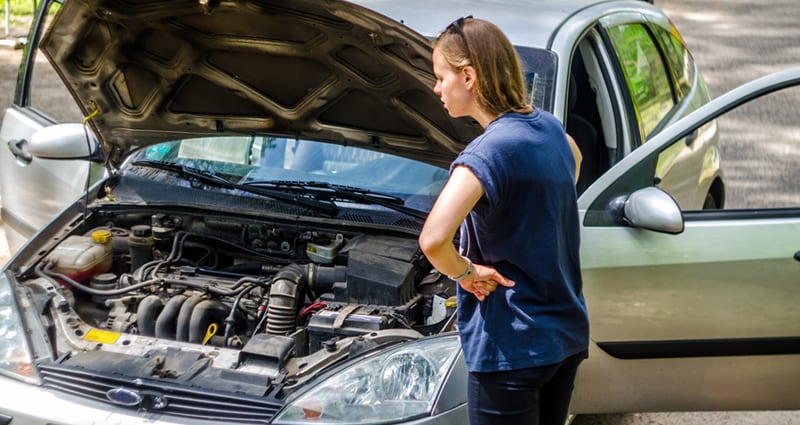 It's summer in West Michigan, which means a lot of fun out in the sun, trips to the beach, or trekking up north for a weekend of camping. While we can stay cool by hanging out in the shade or taking a dip in Lake Michigan, our vehicles rely on a complex system of hoses, tanks, and a big heat exchanger called a radiator to do the same. If something isn't working right, it can really put the brakes on a fun-filled weekend before you even make it out of Grand Rapids.
It's summer in West Michigan, which means a lot of fun out in the sun, trips to the beach, or trekking up north for a weekend of camping. While we can stay cool by hanging out in the shade or taking a dip in Lake Michigan, our vehicles rely on a complex system of hoses, tanks, and a big heat exchanger called a radiator to do the same. If something isn't working right, it can really put the brakes on a fun-filled weekend before you even make it out of Grand Rapids.In this Borgman How-To, we're giving you a quick tour of your vehicle's radiator and cooling system so that you can easily spot issues before you hit the road, while they're happening, and take steps to prevent damage to your engine.
What is a Radiator and What Does It Do?
A radiator (sometimes called a rad for short) is a type of heat exchanger mounted at the front of a vehicle. Its purpose is to regulate engine temperature, but it relies on a whole system of plumbing and sensors to accomplish this. These days, just about every vehicle you'll see on the road (except motorcycles) is water-cooled, meaning a closed system of coolant/antifreeze keeps everything within operating temperature. A radiator's job is to push the excess heat out of the engine bay.As hot coolant moves through the coiled up pipes in the radiator, tiny metal fins conduct heat away from them and a fan blows that heat out of the system through the front grille. It's important to remember throughout this article that a radiator is just one piece of a system with a specific job. If you're troubleshooting, keep in mind this system is designed to regulate temperature, not necessarily just keep it cool.
Your Vehicle's Cooling System: A Basic Rundown
When you start your vehicle, your radiator does... nothing! Coolant is circulated between the reservoir and a metal jacket around the engine until the engine gets up to operating temperature. The water pump keeps the coolant pressurized and moving throughout the system. Once the temperature in this smaller track reaches about 190°F, the thermostat kicks in. Think of it like one of those turkey thermometers that pop up, but with a valve inside that allows coolant to move into the rest of the system. The radiator fan will adjust its speed depending on how hard the engine is working.From here, coolant is routed to the radiator to keep it within a certain temperature range, the heater core for your climate control, and into another chamber to exchange heat with the transmission's cooling system. As the coolant heats up it expands, so the radiator cap allows excess air to escape. After hot coolant from the engine passes through the radiator, the cycle repeats.
Signs & Symptoms of a Heat Management Issue:
The two the most obvious signs that your vehicle's radiator or cooling system is failing are frequent overheating and coolant loss. The first won't be noticeable until the engine has run for a while, but missing coolant usually isn't subtle. In most cases, you'll see coolant-colored spots appear in the driveway or thick white smoke from the tailpipe. The easiest way to spot a slow leak is to get into the habit of checking your fluids every other time you get gas.Weather/Environment-Related Overheating
If you find yourself overheating while out driving, many people's first instinct is to pull over and open the hood. Overheating doesn't necessarily mean that the cooling system is failing, it just may be overloaded. Instead of pulling over, try turning off the air conditioning, rolling down the windows, and turning the heater all the way up. This lessens the strain on the engine and sucks heat out of the system. If the temperature gauge doesn't go back down after doing this or if the temperature keeps rising, then it's time to pull over.Random overheating usually occurs in summer when idling for long periods of time in heavy traffic, such as waiting in line to park at one of West Michigan's beaches. This is because your air intake is pulling in hot air from another vehicle's exhaust, and the engine isn't under much load so it doesn't necessarily know to compensate for the heat. If you can't move and turning the heater up isn't allowing the radiator to catch up, try putting the vehicle in park, doing the steps above, and gently revving the engine. This could "wake up" the radiator fan and get things back under control.
Note: If you see any amount of steam coming from beneath the hood, pull over as soon as you safely, possibly can and turn off the engine.
What To Do If Your Radiator/Cooling System Is Failing
If the temperature is still rising despite following the steps above, safely pull over to the side of the road and turn the engine off. Pop the hood and wait a few minutes for things to cool down. Opening the hood too soon could result in burns, especially if there is visible steam coming from the radiator. Listen for any bubbling or strange noises, then check the coolant reservoir level. Do not open the radiator cap.If the coolant levels are normal, give the engine some time to cool down and drive to the nearest service center where a technician can look it over. It could be a bad thermostat, temperature gauge, radiator fan, contaminated coolant, or a faulty sensor somewhere.
If the coolant levels are lower than normal, it's either being lost through a leak in the radiator, one of the hoses, or through a worn gasket in the engine. This is when it's time to call for roadside assistance, but if that isn't an option there might be steps you can take. Below are some common faults in the cooling system:
- Cracked Hose:This is perhaps the most common cause of a leak. These rubber hoses undergo heating up and cooling down every time you use the vehicle, all while holding the system under pressure. Eventually, the rubber degrades and hairline cracks appear, allowing coolant to escape. These cracks get worse over time and can result in a full-blown leak. Starting from the radiator, follow each hose to where it's going and look for signs of residue or active leaking. Sometimes, the hose itself is fine but the clamp at the end is loose. If this is the case, you might be able to carefully readjust the clamp with a screwdriver.In a pinch, cracks or small holes can be duct-taped shut. It's not permanent, but it can be good enough to limp the vehicle to a service center. If you don't have any spare coolant, plain ol' water can be used as a temporary substitute - just be sure to tell the technician.
- Contaminated Coolant:Over time, coolant can degrade and turn a dark, rusty-looking color and lose its effectiveness. It can even start to solidify inside the radiator, making that section less efficient. Discolored coolant can also be a sign that fluids are mixing together, especially if your radiator has a transmission cooler. If your coolant is discolored, the system needs to be flushed and the source of contamination repaired. Coolant should be bright in color, and they are color-coded based on what type you should use. They are not interchangeable.
- Faulty Thermostat:Thermostats themselves are a very simple, inexpensive part but where they're located can make them expensive to replace. A thermostat that doesn't open fully (or at all) will cause overheating, so it's never a bad idea to replace it if the opportunity presents itself. Unfortunately, this isn't something you can fix on the side of the road.
- Hole in the Radiator Itself: If you can't find any coolant residue in/around any of the hoses, the leak may be in the radiator itself. Check the fins, cap, and bottom of the radiator and if you discover a leak, take note of where it is. If it's small enough that it can be patched with something like fast-set epoxy putty (or even chewing gum) then it's worth a shot. Using products like radiator stop-leak or black pepper to plug up a leak should be considered an absolute last resort, but just know that there's no guarantee they will work and often create more problems than they solve.
- Radiator Fan Belt:Not every car has one of these, but if you have a belt-driven radiator fan and the belt is broken, you can replace it with a leg of pantyhose tied into a loop. It's not something you'd want to do for very long, but it can be enough to get you to a service center.
A Few Things You Shouldn't Do To An Overheating Engine:
When an engine is running normally, coolant can become hotter than boiling water depending on what part of the system it's in. Never open the radiator cap on a hot engine, as the coolant is under pressure and will spray out. This information is also printed in no uncertain terms on the radiator cap, so make sure the engine is cool before removing it.Back in the old days, it was common wisdom to plug up a radiator leak with egg whites and water if you were stranded. Its effectiveness is debatable, but on modern radiators, it will almost certainly make things worse. Today's radiators have all sorts of little fins and agitators inside the exchanger to mix the coolant as it moves through, and egg whites will cling to those instead of the leak.
Lastly, do not pour water on an engine block to cool it down faster. The iron will contract too quickly, resulting in a slightly-distorted engine (head gasket repairs that never seem to take) and possibly hairline cracks in the metal.

Having Radiator Trouble in the West Michigan Summer Heat? Visit the Borgman Service Center in Grand Rapids, MI
If your vehicle can't seem to beat the summer heat, make an appointment today with the Borgman Service Center in Grand Rapids, MI. Our friendly and highly-trained technicians will inspect your radiator and cooling system for signs of wear, leaks, or discoloration and make sure you understand any issues before making decisions.Whether you need a new radiator or just a system flush, you can count on us to get you back on the road to adventure. Check out our Latest Service Coupons and Schedule Your Appointment Online. Come see why we're the Best in the West!